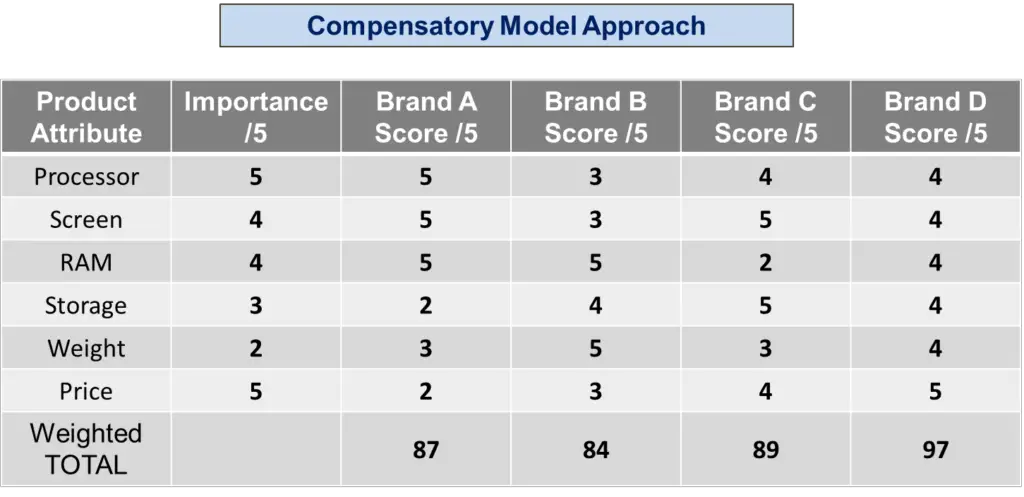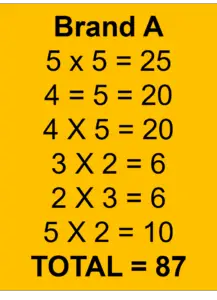Contents
Compensatory Decision Rules in Consumer Behavior
Where Do Compensatory Decision Rules Fit into Consumer Behavior?
When making purchases, all consumers will work through the buyer decision process as follows:
- Need recognition
- Information search
- Evaluation of alternatives
- Purchase
- Post-purchase behavior
Decision rules (or the approach used by consumers) will occur in the ‘evaluation of alternatives’ stage. This is because a decision rule/approach will help the consumer choose between competing alternatives.
In particular, decision rules are more important in mid to high involvement purchase decisions. By having an understanding of how consumers make decisions, marketers can better structure their marketing mix elements.
What is the difference between compensatory and non-compensatory decision models?
Compensatory models look at the overall product offering considering all product attributes. This means that strong attributes can make up for weak attributes when consumers evaluate their choice.
This will occur in the “evaluation of alternatives” stage of the buyer decision process.
In terms of the overall product offering, this means that stronger attributes can compensate for the weaker ones in the consumer’s decision.
For example, a smart TV with a very large screen (a strong product attribute) could make up for an awkward or confusing remote control (a weak product attribute) in the consumer’s mind. Because one attribute is so strong (an ideal attribute to that consumer), the weaker attributes are compensated for.
This is where the name of this decision model comes in. A compensatory decision approach looks at the overall strength of the product attributes combined.
Note: Please see video posted at the end of this article.
Non-compensatory models are where the consumer considers individual product attributes that are important to their purchase – not the overall offering. This is a more common approach to decision making.
In this approach, weaker product attributes are usually considered too unfavorable and the consumer will not buy the product.
How Do Compensatory Decision Rules Work?
An Example of a Consumer Buying a Laptop
Let’s work through the purchase of a laptop computer and how adopting different decision rules can lead to different purchase (choice) decisions.
Let’s start with the compensatory decision-making model. When using this decision rule, we would first start with a list of the various product attributes that we want to look at and consider. And for each of the attributes we would assign an importance score, depending on our needs and preferences.
These scores are shown in the table below, with the importance of each product attribute (scored out of five points) in the second column:
As you can see above, the processor has been scored 5/5, and so has price. This means that these are the two most important product attributes to us.
Weight of the laptop is the least important to us, as we have scored that attribute only 2/5.
We then also score each of the brands out of five (or another number of your choosing) – as shown in the above table for Brands A to D.
And we then multiply each brand’s attribute score by importance – for each attribute. This is shown below for Brand A:
As you can see, the TOTAL score for Brand A is 87. It does not matter what the maximum score is because we are only interested in comparing each brand’s score.
For Brand A, we have multiplied ‘processor’ importance of 5 by Brand A processor score of 5 to get 25. We then repeat for each attribute, and then total the scores (as shown above) – and that’s how we get to 87 points in total.
We undertake the same calculation process for each brand in turn.
And as we can see from the above table, Brand D has the highest score at 97 points, making it the best choice for this consumer. Whereas Brand B scored 84 points, making it a poor choice for this consumer.
Compensatory Decision Rule Approach is a Scoring Model
As demonstrated above, the compensatory decision rule approach uses a scoring model. This is where ALL the product attributes are considered and are assigned a score.
Each Consumer is Different
In the above example, Brand D had the highest score and would be, therefore, the best choice for this consumer.
But does that mean that all consumers will choose Brand D? Not necessarily.
This is because each consumer will construct their scoring model differently to suit their needs and circumstances. For example, another consumer could score ‘weight’ of the laptop at 5/5 in terms of importance, because they need to frequently travel with their computer. And they might score ‘price’ as 3/5 in importance, and so on.
Changing the importance scores will change all the calculations and most likely change the total scores and selection of the best brand.
And even the individual brand scores would differ between consumers. How does this happen? It is due to different perceptions of the brands.
For example, a different consumer may perceive levels of RAM or screen size differently. The same screen size might be scored 4/5 by one consumer, and 3/5 by another – depending upon their perception.
Again, this will change the overall and relative scores, most likely leading to a different choice of the best brand offering.
Video on Compensatory and Non-Compensatory Decision Rules
Related Articles


